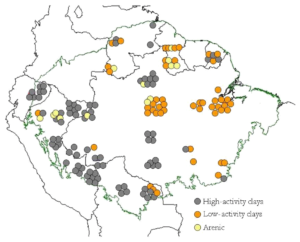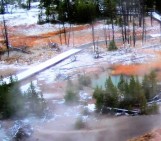
The Amazon rainforest covers an area of 5.5 million km² and is well known for being an invaluable global resource for carbon storage. But it’s not just the trees and vegetation of the Amazonian rainforest that lock in and store carbon – the very soil in these forests can do the same thing, according to research published in EGU’s journal SOIL earlier this year. In this study Carlos Alberto Quesada and his colleagues discovered that the age of the soil is a big control on how different tropical forest soils store carbon.

Geographic distribution of 147 study sites across the Amazon Basin, according to the different soil groups. Each point is a 1 hecatre plot. Orange dots (dominantly in the eastern Amazon) represent low-activity clays, grey dots (dominantly in the western and central Amazon) represent high activity clays, yellow dots (no dominant pattern) represent arenic or sandy soils, from Quesada et al, 2020.
After collecting 147 shallow soil samples from across the Amazon Basin, the researchers divided them into several types depending on how weathered, and therefore how old, they were. The team then conducted several tests to calculate where in the soils the forest’s organic carbon was binding. This stabilisation of plant-based organic carbon depends on the ability of the minerals in the soil to react with the carbon – and this varies all over the world, depending on many factors including the soil’s pH and mineralogy.
In this study the researchers found that the oldest Amazon soils, some of which had been developing for up to 2 billion years, stored organic carbon by trapping it in the pore spaces present between grains. These older, more weathered soils also use clay to stabilise carbon, either through binding the carbon with the clay chemically, or by trapping carbon as it penetrates between the clay’s expanding mineral layers. By comparison, in the younger soils, which have only been developing for about the last 2 million years, the carbon was more frequently bound with oxides of aluminium to create very stable, long-lasting compounds.
As around 40% of Amazonian soils, particularly in the western Amazon, are these younger, developing soils, the importance of aluminium in them cannot be understated, as it allows the organic carbon to remain locked in the soil for much longer periods of time. This ‘aluminium binding’ enables these younger Amazonian soils to store just as much carbon as the tropical plants above ground themselves do over time – a finding that shows just how vital Amazonian soils are to combating climate change.
In this paper, the authors suggest that as vegetation in the Amazon photosynthesises more atmospheric carbon into organic carbon, forest soils will provide the essential next step in this storage process, locking that organic carbon away by drawing it from the leaf litter into the soil. In this way, this thin layer of crucial soils spread across the Amazon are helping us to counteract humanity’s overloading of atmospheric carbon.



